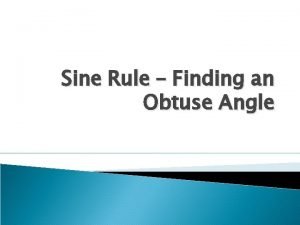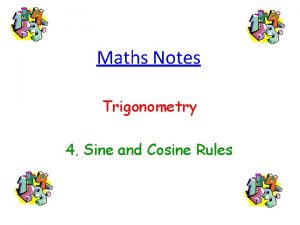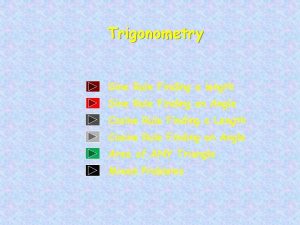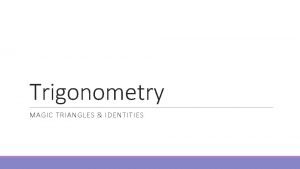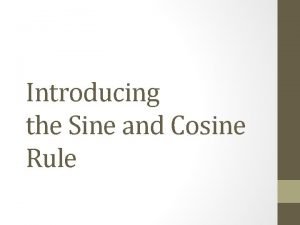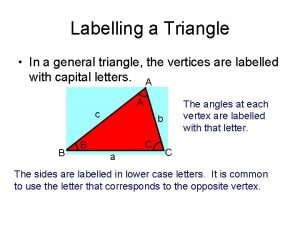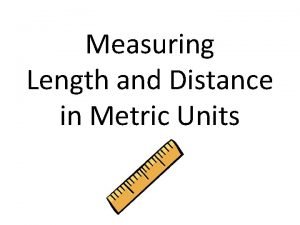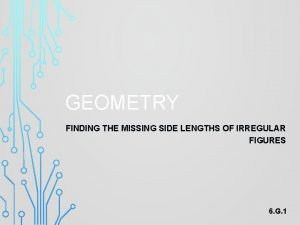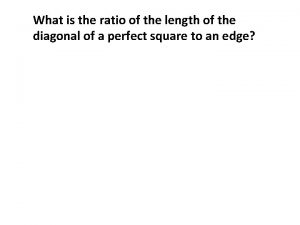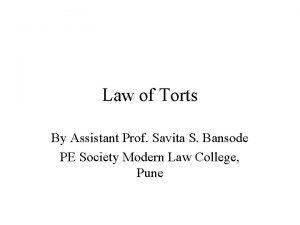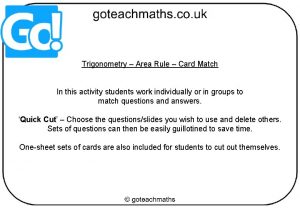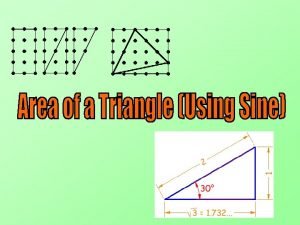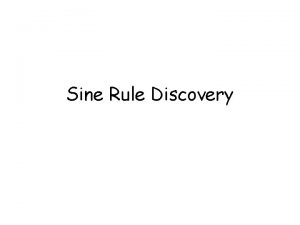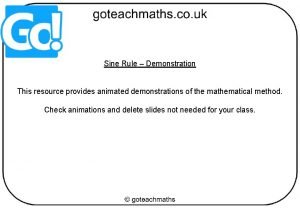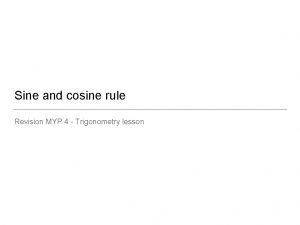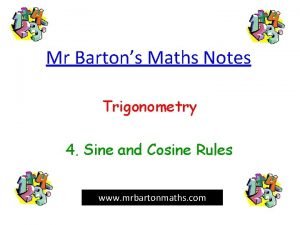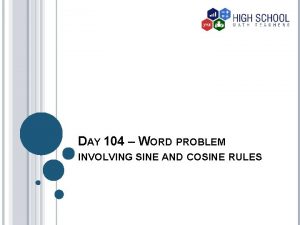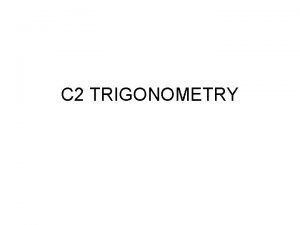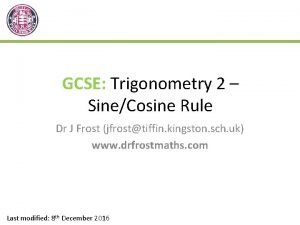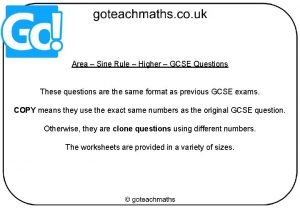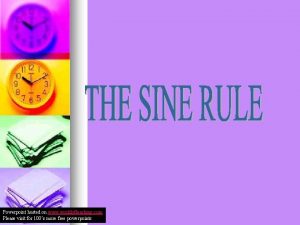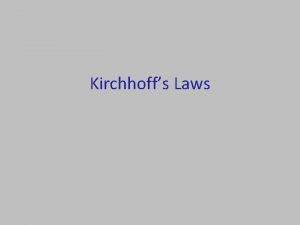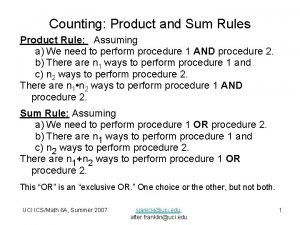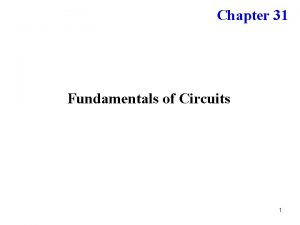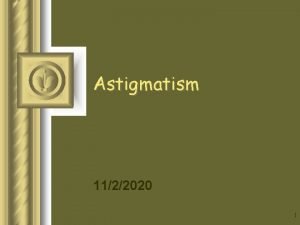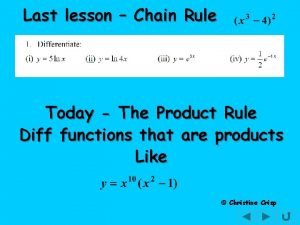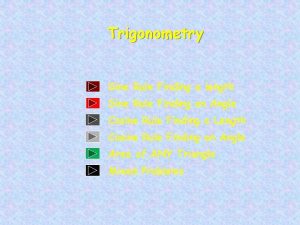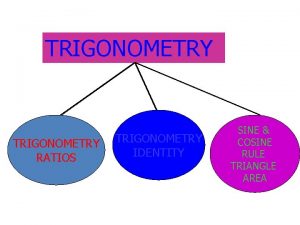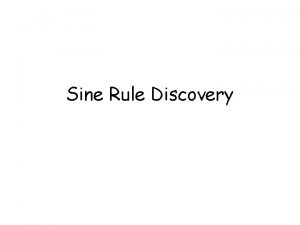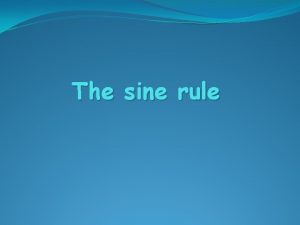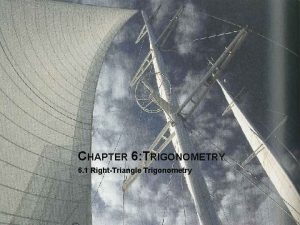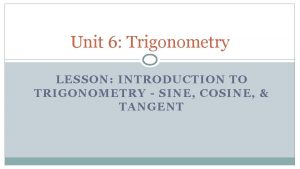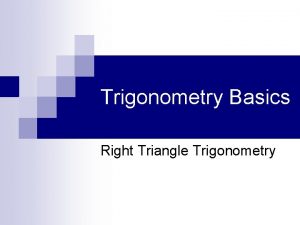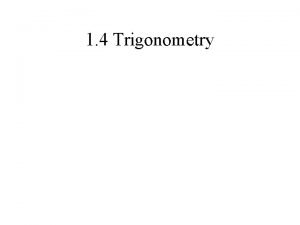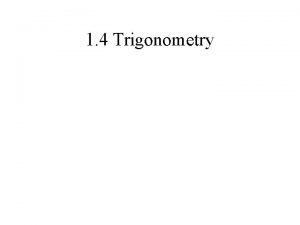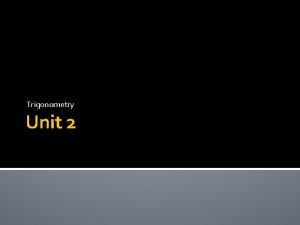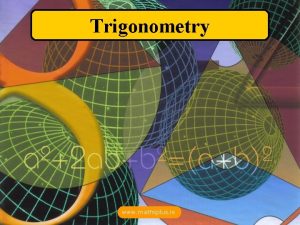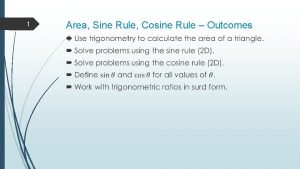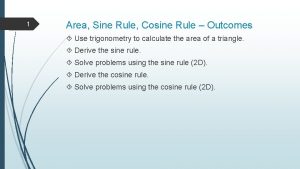Trigonometry Sine Rule Finding a length Sine Rule






































- Slides: 38

Trigonometry Sine Rule Finding a length Sine Rule Finding an Angle Cosine Rule Finding a Length Cosine Rule Finding an Angle Area of ANY Triangle Mixed Problems

Sine Rule Learning Intention 1. To show to use the sine rule to solve REAL LIFE problems involving finding the length of a side of a triangle. Success Criteria 1. Know how to use the sine rule to solve REAL LIFE problems involving lengths.

Sine Rule Works for any Triangle The Sine Rule can be used with ANY triangle as long as we have been given enough information. B a c A C b

The Sine Rule Consider a general triangle ABC. Deriving the rule C b a B P c A Draw CP perpendicular to BA This can be extended to or equivalently

Calculating Sides Using The Sine Rule Example 1 : Find the length of a in this triangle. B a 10 m A 41 o Match up corresponding sides and angles: Rearrange and solve for a. 34 o C

Calculating Sides Using The Sine Rule Example 2 : Find the length of d in this triangle. D 10 m o 133 C 37 o Match up corresponding sides and angles: E d Rearrange and solve for d. = 12. 14 m

What goes in the Box ? Find the unknown side in each of the triangles below: 12 cm (1) a 32 o (2) 47 o b 72 o 93 o 16 mm A = 6. 7 cm B = 21. 8 mm

Sine Rule Learning Intention 1. To show to use the sine rule to solve problems involving finding an angle of a triangle. Success Criteria 1. Know how to use the sine rule to solve problems involving angles.

Calculating Angles Using The Sine Rule B Example 1 : Find the angle 45 m 38 m Ao A 23 o Match up corresponding sides and angles: Rearrange and solve for sin Ao = 0. 463 Use sin-1 0. 463 to find Ao C

Calculating Angles Using The Sine Rule Example 2 : 75 m X Find the angle Xo 143 o Z 38 m Y Match up corresponding sides and angles: Rearrange and solve for sin Xo = 0. 305 Use sin-1 0. 305 to find Xo

What Goes In The Box ? Calculate the unknown angle in the following: (1) 100 o 8. 9 m Ao (2) 12. 9 cm Bo 14. 5 m Ao = 37. 2 o 14. 7 cm Bo = 16 o

Cosine Rule Learning Intention 1. To show when to use the cosine rule to solve problems involving finding the length of a side of a triangle. Success Criteria 1. Know when to use the cosine rule to solve problems. 2. Solve problems that involve finding the length of a side.

Cosine Rule Works for any Triangle The Cosine Rule can be used with ANY triangle as long as we have been given enough information. B a c A C b

The Cosine Rule generalises Pythagoras’ Theorem and takes care of the 3 possible cases for Angle A. Deriving the rule B Consider a general triangle ABC. We require a in terms of b, c and A. BP 2 – (b – x)2 Also: BP 2 = c 2 – x 2 a c = a 2 1 A a 2 = b 2 + c 2 2 a 2 – (b – x)2 = c 2 – x 2 a 2 – (b 2 – 2 bx + x 2) = c 2 – x 2 A x P b b b-x Draw BP perpendicular to AC C a 2 – b 2 + 2 bx – x 2 = c 2 – x 2 a 2 = b 2 + c 2 – 2 bx* a 2 = b 2 + c 2 – 2 bc. Cos. A *Since Cos A = x/c x = c. Cos. A When A = 90 o, Cos. A = 0 and reduces to a 2 = b 2 + c 2 1 Pythagoras When A > 90 o, Cos. A is negative, a 2 > b 2 + c 2 2 Pythagoras + a bit When A < 90 o, Cos. A is positive, a 2 > b 2 + c 2 3 Pythagoras - a bit A a 2 > b 2 + c 2 3 A a 2 < b 2 + c 2

The Cosine Rule The Cosine rule can be used to find: 1. An unknown side when two sides of the triangle and the included angle are given (SAS). 2. An unknown angle when 3 sides are given (SSS). B Finding an unknown side. a 2 = b 2 + c 2 – 2 bc. Cos. A Applying the same method as earlier to the other sides produce similar formulae for b and c. namely: a c A b b 2 = a 2 + c 2 – 2 ac. Cos. B c 2 = a 2 + b 2 – 2 ab. Cos. C C

Cosine Rule Works for any Triangle How to determine when to use the Cosine Rule. Two questions 1. Do you know ALL the lengths. OR SAS 2. Do you know 2 sides and the angle in between. If YES to any of the questions then Cosine Rule Otherwise use the Sine Rule

Using The Cosine Rule Works for any Triangle Example 1 : Find the unknown side in the triangle below: L 5 m 43 o Identify sides a, b, c and angle Ao 12 m a= L b= 5 a 2 = b 2 + c = 12 Ao = 43 o c 2 -2 bccos. Ao Write down the Cosine Rule. 2 a 2 = 52 + 122 - 2 x 5 x 12 cos 43 o Substitute values to find a. a 2 = 25 + 144 - (120 x 0. 731 ) a 2 = 81. 28 a = L = 9. 02 m Square root to find “a”.

Using The Cosine Rule Works for any Triangle Example 2 : 12. 2 m 137 o 17. 5 m Find the length of side M. a = M b = 12. 2 C = 17. 5 a 2 = b 2 + c 2 -2 bccos. Ao Ao = 137 o M Identify the sides and angle. Write down Cosine Rule a 2 = 12. 22 + 17. 52 – ( 2 x 12. 2 x 17. 5 x cos 137 o ) a 2 = 148. 84 + 306. 25 – ( 427 x – 0. 731 ) Notice the two negative signs. a 2 = 455. 09 + 312. 137 a 2 = 767. 227 a = M = 27. 7 m

What Goes In The Box ? Find the length of the unknown side in the triangles: 43 cm (1) 78 o 31 cm L L = 47. 5 cm (2) M 5. 2 m M =5. 05 m 38 o 8 m

Cosine Rule Learning Intention 1. To show when to use the cosine rule to solve REAL LIFE problems involving finding an angle of a triangle. Success Criteria 1. Know when to use the cosine rule to solve REAL LIFE problems. 2. Solve REAL LIFE problems that involve finding an angle of a triangle.

Cosine Rule Works for any Triangle The Cosine Rule can be used with ANY triangle as long as we have been given enough information. B a c A C b

Finding Angles Using The Cosine Rule Works for any Triangle Consider the Cosine Rule again: a 2 = b 2 + c 2 -2 bccos. Ao We are going to change the subject of the formula to cos A o b 2 + c 2 – 2 bc cos Ao = a 2 Turn the formula around: -2 bc cos Ao = a 2 – b 2 – c 2 Take b 2 and c 2 across. Divide by – 2 bc. Divide top and bottom by -1 You now have a formula for finding an angle if you know all three sides of the triangle.

Finding Angles Using The Cosine Rule Works for any Triangle Example 1 : Calculate the unknown angle Ao. 9 cm 11 cm Ao 16 cm Write down the formula for cos Ao Ao = ? a = 11 b = 9 c = 16 Label and identify Ao and a , b and c. Substitute values into the formula. Cos Ao = 0. 75 Calculate cos Ao. Ao = 41. 4 o Use cos-1 0. 75 to find Ao

Finding Angles Using The Cosine Rule Works for any Triangle Example 2: Find the unknown yo 15 cm 13 cm Angle yo in the triangle: 26 cm Write down the formula. Ao = y o a = 26 b = 15 c = 13 Identify the sides and angle. Find the value of cos. Ao = - 0. 723 Ao = y o = 136. 3 o The negative tells you the angle is obtuse.

What Goes In The Box ? Calculate the unknown angles in the triangles below: (1) 5 m Ao 10 m Ao =111. 8 o 7 m (2) 12. 7 cm Bo 8. 3 cm 7. 9 cm Bo = 37. 3 o

Area of ANY Triangle Learning Intention 1. To explain how to use the Area formula for ANY triangle. Success Criteria 1. Know the formula for the area of any triangle. 2. Use formula to find area of any triangle given two length and angle in between.

Labelling Triangles In Mathematics we have a convention for labelling triangles. B a c A C b Small letters a, b, c refer to distances Capital letters A, B, C refer to angles

Labelling Triangles Have a go at labelling the following triangle. E d f D F e

General Formula for Area of ANY Triangle Co Consider the triangle below: Ao Area = ½ x base x height b a h Bo c What does the sine of Ao equal Change the subject to h. h = b sin. Ao Substitute into the area formula

Key feature Area of ANY Triangle To find the area you need to knowing The area of ANY can be found 2 sides andtriangle the angle byinthe following formula. between (SAS) B a c A C b Another version

Area of ANY Triangle Example : Find the area of the triangle. B c A The version we use is 20 cm 30 o 25 cm C

Area of ANY Triangle Example : Find the area of the triangle. The version we use is E 60 o 8 cm D 10 cm F

Key feature What Goes In The Box ? Remember (SAS) Calculate the areas of the triangles below: (1) 12. 6 cm A = 36. 9 cm 2 23 o 15 cm (2) 5. 7 m 71 o 6. 2 m A = 16. 7 m 2

Mixed problems Learning Intention 1. To use our knowledge gained so far to solve various trigonometry problems. Success Criteria 1. Be able to recognise the correct trigonometric formula to use to solve a problem involving triangles.

Exam Type Questions Angle TDA = 180 – 35 = The angle of elevation of the top of a building measured from point A is 25 o. At point D which is 15 m closer to the building, the angle of elevation is 35 o Calculate the height of the building. 145 o Angle DTA = 180 – 170 = 10 o T 36. 5 B 10 o 35 o 145 o 25 o D 15 m A S OH C A H T OA

Exam Type Questions A fishing boat leaves a harbour (H) and travels due East for 40 miles to a marker buoy (B). At B the boat turns left and sails for 24 miles to a lighthouse (L). It then returns to harbour, a distance of 57 miles. (a) Make a sketch of the journey. (b) Find the bearing of the lighthouse from the harbour. (nearest degree) L 57 miles H 24 miles A 40 miles B

Exam Type Questions The angle of elevation of the top of a column measured from point A, is 20 o. The angle of elevation of the top of the statue is 25 o. Find the height of the statue when the measurements are taken 50 m from its base T o o o Angle BCA =180 – 110 = 70 Angle ACT = 180 – 70 = 110 Angle ATC = 180 – 115 = 65 65 o 110 o C 70 o 21 53. 5 o A 20 o 25 o m S OH C A H T OA 50 m B

Exam Type Questions An AWACS aircraft takes off from RAF Waddington (W) on a navigation exercise. It flies 530 miles North to a point (P) as shown, It then turns left and flies to a point (Q), 670 miles away. Finally it flies back to base, a distance of 520 miles. Find the bearing of Q from point P. Not to Scale P 670 miles 530 miles Q 520 miles W
 When do we use the cosine rule
When do we use the cosine rule Obtuse angles trigonometry
Obtuse angles trigonometry Trigonometry cosine rule
Trigonometry cosine rule Sine rule length
Sine rule length Trig magic triangles
Trig magic triangles Sine rule and cosine rule
Sine rule and cosine rule Sine rule cosine rule
Sine rule cosine rule Cosine rule for angle
Cosine rule for angle Finding arc length
Finding arc length Distance metric system
Distance metric system How do you find the missing side length
How do you find the missing side length What is the ratio of the length of to the length of ?
What is the ratio of the length of to the length of ? Lex stricta
Lex stricta Nulla poena sine lege
Nulla poena sine lege Injuria sine damno and damnum sine injuria difference
Injuria sine damno and damnum sine injuria difference Trigonometry area rule
Trigonometry area rule Area of triangle using sine
Area of triangle using sine What is an ambiguous case in trigonometry
What is an ambiguous case in trigonometry Negative cosine graph
Negative cosine graph Proof of the sine rule
Proof of the sine rule Sine rule
Sine rule Sine rule activity
Sine rule activity Sine maths
Sine maths Cosine word problems
Cosine word problems Sine rule questions
Sine rule questions Sine rule
Sine rule Dr frost sine rule
Dr frost sine rule Sine rule gcse questions
Sine rule gcse questions Ambiguous triangle case
Ambiguous triangle case Sine rule powerpoint
Sine rule powerpoint Loop rule and junction rule
Loop rule and junction rule Product and sum rule
Product and sum rule Dillon rule
Dillon rule Kirchhoff's loop rule example
Kirchhoff's loop rule example With the rule astigmatism
With the rule astigmatism Simple myopic astigmatism example
Simple myopic astigmatism example With the rule astigmatism axis
With the rule astigmatism axis Product rule vs chain rule
Product rule vs chain rule General power rule vs power rule
General power rule vs power rule

